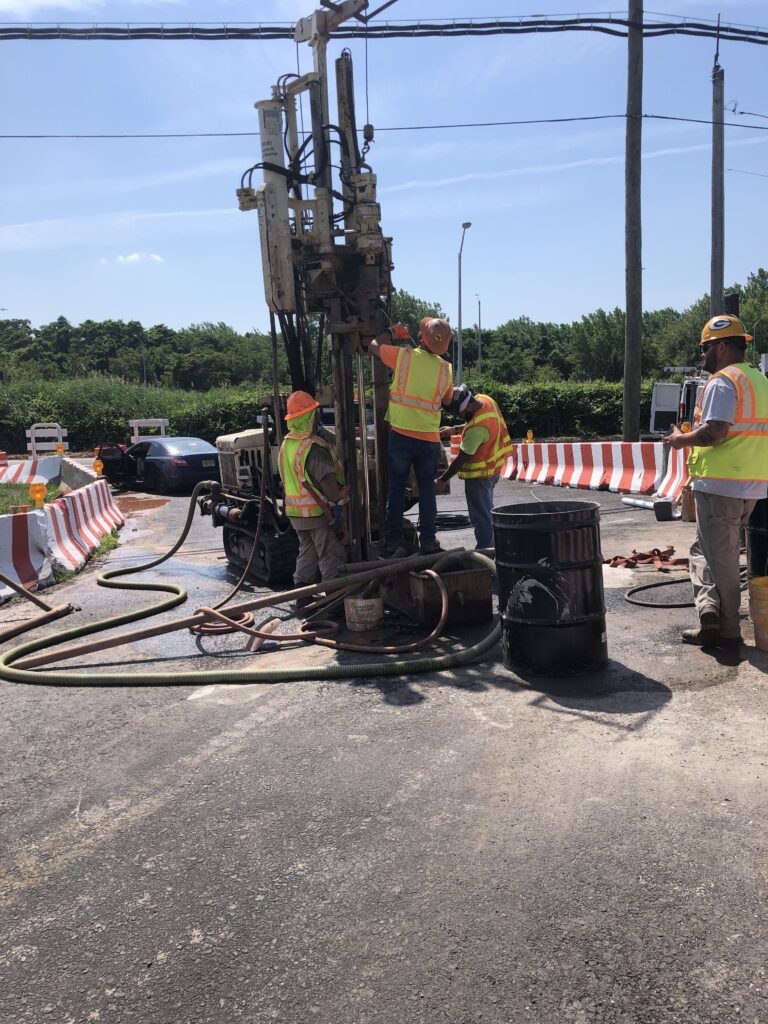- Gilbane Building Company
- Staten Island, NY
- 2020
Tectonic provided construction phase monitoring services that included wo (2) preconstruction condition surveys, vibration monitoring, ground deformation monitoring, survey monitoring, and crack monitoring.
A monitoring plan was submitted and implemented during the vibration and displacement inducing construction activities throughout the site. The plan identified proposed monitoring locations, means and methods for monitoring, reporting procedures and data reporting requirements. The purpose of the monitoring program was to reduce the likelihood of construction-induced damage to the adjacent structures and to detect early signs of displacement or structural distress.
Tectonic installed four (4) Instantel Micromate seismographs equipped with borehole geophones to monitor continuous vibration levels during the horizontal direction drilling activities. The geophones were placed into a 4-inch diameter borehole at the desired elevation and grouted in-place. The units were equipped with a 100-foot geophone extension cable, which was trenched from the borehole location through the asphalt to a secure location. The units were powered via solar panels. The seismographs were capable of measuring peak particle velocity from 0.01 to 10 inches per second with an accuracy of +/- 5 percent of the measured peak particle velocity, or 0.02 inches per second, whichever was larger, at frequencies between 4 and 125 Hertz. The resolution was .005 inches per second.
The vibration monitoring data was transmitted wirelessly through Instantel’s remote access Auto Call Home feature and a cellular modem. Whenever an exceedance event occurred or the machine was scheduled to download daily data, the monitor automatically connected and downloaded all event data to a remote server stored at Tectonic’s office. The vibration data was plotted and posted on our web-based monitoring website, which was accessible to the project team.
In addition, four (4) Geokon Model 1280 extensometers within 4” diameter boreholes at elevations from 0’ to -10.3’ that monitored continuous deformation levels during the horizontal direction drilling activities. The extensometers anchors were placed into boreholes at the desired elevation using continuous lengths of fiberglass rods inside protective tubing and grouted in-place. Following completion of the installation, the units were connected to Geokon Model 4400 vibration wire displacement transducers and were housed in a 12-inch diameter flush mounted manhole cover to protect the equipment. The Vibrating Wire Displacement Transducers were capable of reading deformation levels with +/- 0.1 percent accuracy and were connected to a 5-channel load sensing node, which recorded and reported the monitoring data in real-time. The extensometer data was plotted and posted on our web-based monitoring website, which was accessible to the project team.
Four (4) Geokon Model 4830 pressure cells to monitor continuous stress levels during horizontal directional drilling activities were also installed. The pressure cells had a working range of 0-100 psi. The cells were installed within a 4-inch diameter borehole to a depth of approximately 21 feet below existing grade, and then pushed into the soil and grouted in place. Following the completion of the installation, a 12-inch diameter flush mount manhole cover was installed to protect the equipment. The pressure cells were coupled with Geokon Model 4450 Vibrating Wire Displacement Transducers capable of reading stress levels with +/- 0.1 percent accuracy. The transducers were connected to a single channel load sensing node, which recorded and reported the monitoring data in real-time. The pressure cell data was plotted and posted on our web-based monitoring website, which was accessible to the project team.
Tectonic representatives installed four (4) groundwater wells approximately 25-feet from the edges of the sheet pile support of excavation walls. The two-inch observation wells were drilled to 20-feet below ground surface with a 10-foot slotted screen and 10-foot solid riser consisting of schedule 40 PVC. The annulus was backfilled with No. 1 filter sand to one foot above the slotted screen. The annulus above the filter sand was sealed using a bentonite hole plug using 3/8-inch coarse grade Wyoming sodium bentonite and capped using a steel flush mount cap at the surface. Tectonic’s inspector took weekly readings during the dewatering and the cutoff wall penetration activities.
An Automated Total Station (AMTS) was installed on a nearby building to monitor the adjacent structures and SOE during construction. High precision prisms were placed on the structures and SOE and measured on a daily basis by the AMTS. Deviations in X, Y & Z coordinates were made available on a dedicated website hosted by Tectonic.

